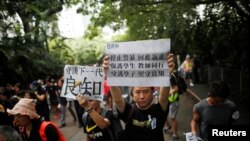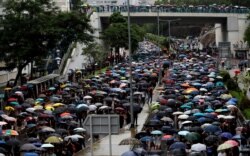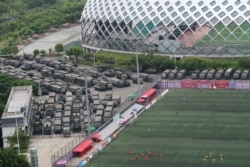Updated Aug. 17, 2019, 10:50a.m.
HONG KONG — Pro-democracy protesters marched on one side of Hong Kong’s famous harbor on Saturday to demand the government heed their demands. Across the water, a pro-government rally called for an end to the often violent protests.
The dueling demonstrations highlighted the political divide in the semiautonomous Chinese territory, which for 10 weeks has been rocked by protests that show no signs of relenting.
“The government right now doesn’t listen to the people, and the police are too violent,” said Bobby Tse, a 76-year-old retiree who watched the pro-democracy march from a bridge. “It didn’t used to be like this. We didn’t have to protest every week. But now even though we have protests every week, the government still gives no response.”
At the pro-government rally, speakers on a stage said they love both Hong Kong and China and asked the protesters why they are afraid of China. Supporters gave a thumbs-up to police officers and posed for photos with them. Leo Chen, a 47-year-old driver, said he came out because he wants peace in his city of 7.4 million people.
“Before, everyone in Hong Kong helped each other, it was very harmonious,” he said. “Now to see it become like this, I’m not happy, so I’ve come out to show a little strength.”
Earlier Saturday, thousands of schoolteachers marched to the official residence of Hong Kong’s leader, Carrie Lam, to show support for the protesters, who have taken to the streets since early June and include many students.
Carrying signs that read “Protect the next generation” and umbrellas to ward off intermittent downpours, the teachers tied white ribbons to a metal fence near Government House. They said the government should answer the protesters’ demands and stop using what they called police violence to disperse demonstrators who have taken over streets and besieged and defaced government buildings.
“We want to protect our students, our youngsters, so teachers are willing to come out and speak for the youngsters, and also, to stand by them so they are not alone,” said Fung Wai-wah, president of the Hong Kong Professional Teachers’ Union, which organized the march.
The movement’s demands include Lam’s resignation, democratic elections and an independent investigation into police use of force. A rally in Victoria Park has been called for Sunday by a pro-democracy group that has organized three massive marches through central Hong Kong since June.
“Even though we’re all scared of getting arrested, we have to keep going,” said Minnie Lee, a 31-year-old logistics worker who joined the pro-democracy march. “What we are fighting for is democracy and our rights. We’re not doing anything wrong. If we stop now, things will only get worse.”
Tensions rose briefly after the march, with riot police deployed to chase down a group of pro-democracy protesters they said were assembling illegally outside their station, shining laser pointers and throwing eggs.
Officers formed a line on a nearby street, thumping their batons on their shields before charging.
But by that time, most protesters had already melted away into the city’s densely populated Mong Kok district, leaving officers to face angry local residents, who told them to leave and accused them of being members of crime gangs. The police eventually left without firing tear gas.
Members of China’s paramilitary People’s Armed Police force have been training this week across the border in Shenzhen, fueling speculation that they could be sent in to suppress the protests. Officers didn’t appear to hold major drills on Saturday, but could be seen doing jumping jacks and stretching inside a sports stadium. Dozens of army-green armored carriers and trucks were parked inside and outside the facility.
The Hong Kong police, however, have said they are capable of handling the protests.
“I can tell you we’re confident the police have the capability to maintain law and order,” Yeung Man-pun, commander of the Kowloon City district, said Friday when asked about the possibility of a deployment of mainland security forces.
Outside of Hong Kong, demonstrations were held in support of both the pro-democracy movement and China.
Australia, Taiwan protests
In Australia, at least 200 protesters descended on Sydney Town Hall, chanting “Long live China” and singing the Chinese national anthem, while a protest in support of the pro-democracy movement continued in Melbourne.
The Melbourne rally had turned ugly on Friday night, with police moving in to separate some 100 pro-China protesters from those sympathetic to Hong Kong. Saturday’s protest in the southern city was peaceful.
In Taiwan, people held a flash mob demonstration in Taipei, the island’s capital, in support of the Hong Kong protests.










